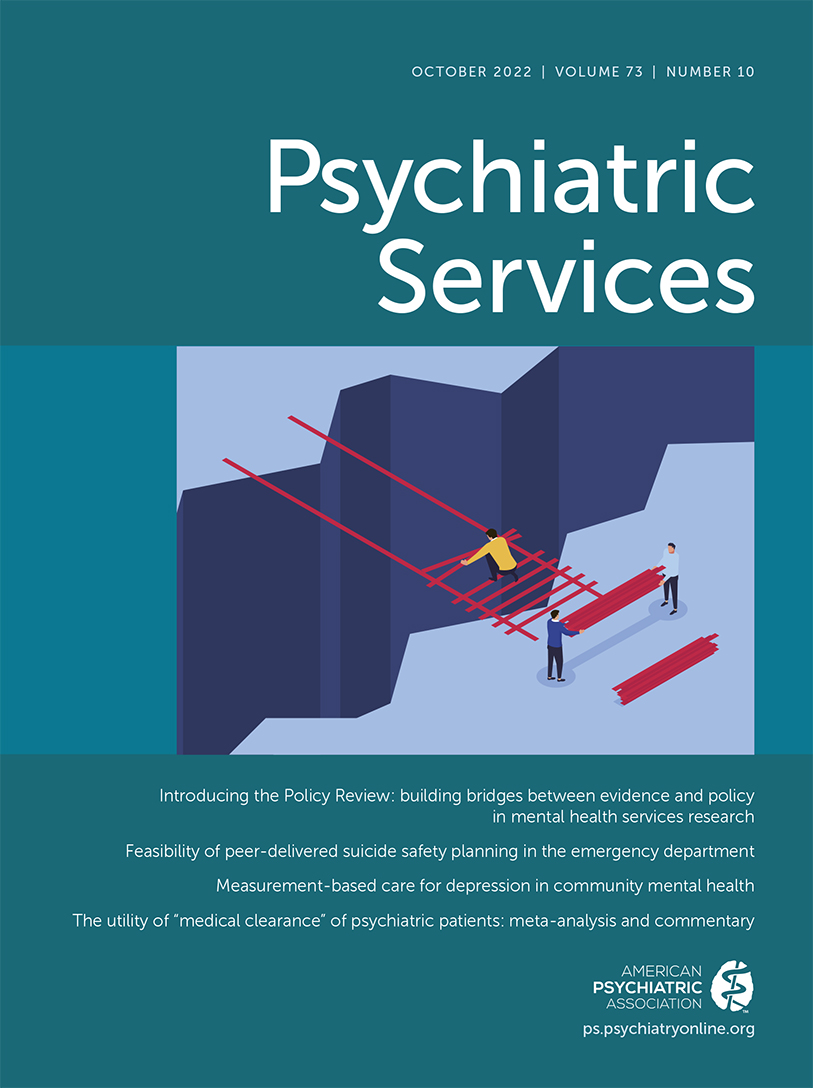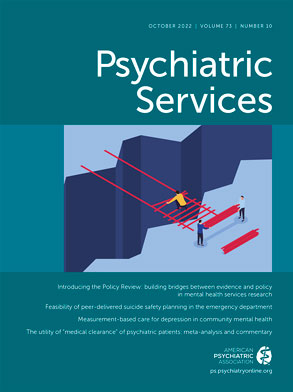Peer support services are increasingly common within behavioral health systems serving older youths and young adults (“young people”) with serious mental health conditions (
1). This growth has been fueled in part by research in general adult populations showing that peer support services can enhance outcomes in a variety of areas, including service engagement and retention, hope and belief in the possibility of recovery, empowerment and self-efficacy, and social inclusion and engagement (
2). There has been speculation that peer support may be particularly helpful for young people because existing behavioral health systems do not adequately attract or engage them. Furthermore, being employed as young adult peer support specialists (YPSSs) can provide an important step on the career path for young people with serious mental health conditions (
3), who experience many challenges in their career development.
Both implementation of peer support and research into its effectiveness are hindered by a lack of specification regarding peer support roles (
1,
4), and peer support providers report that they are often tasked with developing their own roles from scratch (
4,
5). Numerous studies of populations across the general workforce have shown that a lack of role clarity is associated with heightened job-related stress, job dissatisfaction, intentions to quit one’s job, and poor mental health (
6). A lack of role clarity also has been linked to job-related stress among peer support providers specifically (
5) and thus may pose a risk to these individuals’ own recoveries.
In response to these challenges, researchers partnered with young adults with extensive experience receiving intensive mental health services—including young adults who had experience as YPSSs—to develop PLUS, a skills enhancement and role clarification intervention for YPSSs. PLUS was designed to complement existing training for YPSSs by clarifying needed skill sets and by providing a set of practice templates that YPSSs can use to support person-centered planning in one-on-one work with young people. PLUS was designed to fit any service context in which YPSSs are tasked with supporting young peoples’ progress on self-identified goals, regardless of whether peer support is offered as a standalone service or is integrated within a larger package of services provided to a young person.
PLUS training was designed to be consistent with best practices for skills enhancement, which emphasize the importance of cycles of observation-based feedback and coaching and the importance of having trainers who are perceived as having credibility derived from appropriate experience and expertise. PLUS training incorporated these best practices by featuring interactive workshops led or co-led by young adults who had worked as YPSSs as well as online “remote” coaching to provide trainees with one-on-one feedback on video-recorded examples of their work. The purpose of this study was to investigate the feasibility and acceptability of the PLUS skills enhancement intervention and the PLUS training intervention and to assess training satisfaction and outcomes among YPSSs who received training.
PLUS Study
Participants in this study were YPSSs ages 21–28 who were working in programs that provide mental health services to individuals ages 16–24. Each program used person-centered planning as part of the process for developing care or treatment plans to address mental health concerns and related needs. Within each program, the YPSS role was responsible for supporting young people to interact with other providers and treatment teams in an empowered and productive manner, to identify personally meaningful goals and ensure that the goals were included in their care or treatment plan, and to build relationships with supportive individuals in the community and carry out community-based activities related to the goals in the treatment plan. Participants provided written consent after being fully informed about the study and its potential risks and benefits. Of the 27 YPSSs who began the training, 22 completed it; however, two had missing follow-up data. All five noncompleters left their agencies during the 4-month study period.
YPSSs carry out PLUS with young people by facilitating conversations guided by a series of templates that, together, provide a structure for person-centered planning. A YPSS is expected to begin their work with a young person by completing the templates in order—starting with those related to exploring strengths, passions, assets, and motivators (SPAMs), followed by those related to identifying activities connected to personally meaningful goals, followed by those related to planning and carrying out identified activities (which may include meetings with the treatment team, providers, and other allies or gatekeepers)—and debriefing afterward. Thereafter, the YPSS “recycles” portions of the templates as needed to maintain the PLUS process. Throughout the planning process, YPSSs are expected to demonstrate six types of skills: moving through a person-centered planning process in a structured yet flexible manner; ensuring that planning is driven by the young person’s goals, perspectives, and priorities; collaborating with the young person to build appreciative understanding of their SPAMs; supporting the young person to carry out activities in the community; teaching and supporting the use of self-determination skills; and effectively using “peerness.”
The interactive workshops for PLUS are held every other week for 15 weeks. Between the workshops, trainees complete homework using an Internet-based training and coaching platform (i.e., a virtual coaching platform [VCP]). Trainees access the VCP to watch video clips that exemplify good (and not-so-good) use of PLUS materials and skills. They also use the VCP to upload video-recorded samples of their work with young people. Trainers review the videos by using a coding framework that is integrated into the VCP and then schedule one-on-one coaching sessions to review an online feedback report generated through the VCP. The feedback report includes a description of key practice strengths and areas for improvement related to the PLUS skills as well as live links to the portions of the uploaded video that exemplify trainees’ practice strengths and improvement areas. In total, trainees spend about 20 hours participating in training- and coaching-related activities.
Data for the study were drawn from ratings of trainees’ skills as demonstrated in the uploaded videos and from pre- and posttraining online surveys completed by trainees. Trainee videos were rated by using an existing observational rating system (
7) that assesses five of the six skills areas listed previously. (Because of difficulties in achieving interrater reliability, peerness was not rated with the observational system.) A self-assessment of skills (
7) covering three key skill areas (i.e., ensuring that planning is driven by the young person’s goals, perspectives, and priorities; collaborating to build an understanding of the young person’s SPAMs; and teaching and supporting the use of self-determination skills) was included on both the pre- and posttraining surveys. Five items related to peerness skills were added to the pre-existing self-assessment for this study. These items included, How confident are you that you know how to share parts of your own story in a way that benefits a young person you’re working with? and How confident are you that you can build a relationship with a young person that is different from a friendship and from other therapeutic relationships? For each item, trainees rated their confidence for performing a given skill from 0, not at all confident, to 100, completely confident. Both surveys also included brief versions of commonly used assessments of role clarity and anxiety related to the ability to perform one’s job competently (i.e., “professional inefficacy”) (
6). Both assessments were rated on a scale ranging from 1, almost never, to 5, almost always. The posttraining survey also included trainee ratings of the importance of training goals, the credibility of the trainers, training organization, trainees’ confidence that they could apply PLUS in their day-to-day work, and the overall impact of the training on their work with young people. Each of the items was rated on a scale from 1, not at all important, credible, etc., to 10, extremely important, credible, etc. Study materials and procedures were approved by the institutional review board at Portland State University.
Results
As shown in the table provided in the online
online supplement, trainees’ ratings of their confidence in each of the four skill areas on the self-assessment increased significantly pre-post intervention, with effect sizes between 0.66 and 1.25. Ratings of role clarity were essentially unchanged, whereas role-related anxiety decreased significantly (effect size=0.66). Ratings of trainees’ video-recorded practice increased in each skill area, with statistical significance of at least p<0.10 (a somewhat relaxed threshold often used in small pilot studies) in every area except SPAMs and with small-to-medium effect sizes.
Discussion and Implications
All trainees who participated in the study were employed as peer support providers and had received previous training for the role. Thus, the results provide initial support for the PLUS training as an enhancement to other training interventions for the YPSS role. The findings also support the potential usefulness of a purely remote coaching process, a relatively low-cost method for implementing best practices for training to an extent that significantly exceeds what is typical for training programs offered in community mental health settings.
Trainees expressed high levels of satisfaction with the training and particularly with the credibility of the trainers, which is noteworthy given that training sessions were led or co-led by young adults who had previously received services for serious mental health conditions. It is possible that shared lived experience and perceptions of peerness contributed to trainees’ favorable assessment of the training and the trainers; however, we did not gather data that could be used to substantiate this theory.
More generally, peerness proved difficult for the study’s research team to define in concrete terms. As noted earlier, the team was not successful in reliably identifying peerness when rating trainees’ video-recorded practice samples. Even after many discussions, and despite conviction that peerness could be defined concretely, the team was left with numerous questions about how to recognize this skill and about the meaning of shared lived experience in a context in which young people may have more differences—e.g., gender, race-ethnicity, cultural background, socioeconomic resources, educational attainment, “success” in mental health programs and systems—than similarities with their YPSSs. This difficulty highlights the need for future work aimed at achieving a more nuanced understanding of peerness, how it develops (or doesn’t develop) in relationships between YPSSs and young people, and the extent to which it mediates other impacts of peer support.
In contrast to other outcomes assessed, trainees’ ratings of role clarity did not improve. During informal interviews conducted after training was completed, several participants voiced a belief that their supervisors had not been given sufficient information about PLUS or its integration into peers’ practice and that this deficiency contributed to differing expectations about the peer role. The study team had implemented several strategies aimed at keeping supervisors informed and engaged in PLUS training activities, including orientation webinars, monthly group calls, and individual updates by e-mail and telephone. Before the study, supervisors had agreed to participate in these activities; however, actual participation varied widely. Previous research has clearly demonstrated that nonpeer managers, staff, and supervisors often lack understanding of peer roles and, in fact, may be skeptical or even hostile regarding the value of peer support and particularly young adult peer support (
3). The nonengaged supervisors simply may not prioritize activities with the PLUS project or may not understand that peer roles require specific forms of supervision and support. Thus, the PLUS study findings further highlight the need to change organizational practices, culture, and policies in order to build workplaces that are hospitable to peer work and underscore the need to develop effective strategies to help enact these changes.
This study had significant limitations, including its very small sample and the absence of a control group. Peers’ skills and confidence may have grown over time for reasons unrelated to the training they received. Additional research will be required in order to test whether trainee-level impacts are associated with measurable improvements in the lives of the young people whom the peers support.
Acknowledgments
The authors thank the stakeholders who participated in or supported the study.

